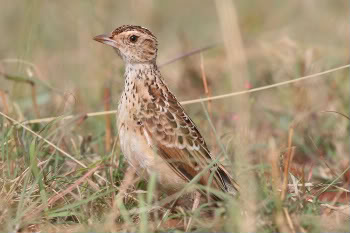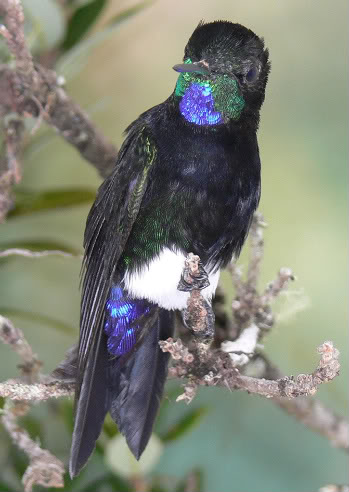|
|
In this year’s updated IUCN Red List on birds, six species were down-listed from Critically Endangered to Endangered, but eight species were up-listed to Critically Endangered, leading to the highest number of Critically Endangered birds ever on the list. In all 1,227 bird species (12 percent) are currently considered threatened with global extinction.
“It extremely worrying that the number of Critically Endangered birds on the IUCN Red List continues to increase, despite successful conservation initiatives around the world,” says Simon Stuart, Chair of IUCN’s Species Survival Commission.
 Ethiopia’s Sidamo lark is Critically-Endangered. Photo by: Greg Davies. |
The new additions to the Critically Endangered category come from all over the world. In Ethiopia the Sidamo Lark Heteromirafra sidamoensis has recently attracted media coverage due to a survey study which concluded that the lark may have the dubious honor of becoming mainland Africa’s first bird extinction.
“Across Africa, widespread birds of prey are also disappearing at an alarming rate, and emblematic species such as Bateleur Terathopius ecaudatus and Martial Eagle Polemaetus bellicosus have been placed in a higher category of threat as a result,” says Jez Bird, BirdLife’s Global Species Programme Officer. “These declines are mirrored in many species, in every continent.”
A newly discovered species from Colombia, the Gorgeted Puffleg Eriocnemis isabellae enters the Red List as Critically Endangered. This hummingbird lives in an increasingly shrinking cloud forest habitat of 1,200 hectares, which is being deforested for coca production.
 New discovered Gorgeted Puffleg is already Critically Endangered. Photo by: Alex Cortes. |
Hawaii’s Palila Loxioides bailleui jumps from Endangered to Critically Endangered. This species is the thirteenth Critically Endangered species in Hawaii. The American state is considered by some to have the most threatened species by area in the world.
The new updated list also reflects a trend noticed by several ornithologists that common birds are becoming less so. One example is North America’s Chimney Swift Chaetura pelagica. After dropping by 30 percent in a decade, this once-abundant species has been moved from Least Concern (the lowest rating on the Red List) to Near Threatened.
“In global terms, things continue to get worse – but there are some real conservation success stories this year to give us hope and point the way forward,” says Dr Leon Bennun, BirdLife’s Director of Science and Policy.
One of the species to be downgraded due to conservation efforts is Lear’s Macaw Anodorhynchus leari. After the population quadrupled due to intensive conservation work the macaw has been moved from Critically Endangered to Endangered.
The Mauritius Fody Foudia rubra is also on the rise. The once Critically Endangered bird was moved to a predator-free island where it is recovering.
Birdlife International, which is the IUCN’s Red List authority, launched the Birdlife Preventing Extinctions Programme last year. The program seeks out longterm donors—either an individual or company—to commit to a Critically Endangered bird’s protection now and in the future. So far, 32 of the 192 species have found ‘champions’.
“What the changes in this year’s IUCN Red List tell us is that we can still turn things around for these species. There just has to be the will to act,” says Dr Stuart Butchart, BirdLife’s Global Research and Indicators Coordinator.
Related articles
Hawaii continues to stand-by as sheep destroy critically-endangered palila bird’s habitat
(03/25/2009) The environmental legal organization, Earthjustice, has filed legal papers against the Hawaii State Department of Land and Natural Resources for failing to keep feral sheep and goats out of the critically-endangered palila bird’s last habitat. According to Earthjustice, the court has already issued three orders beginning in 1979 that found the state of Hawiai in violation of the Endangered Species Act by not protecting the palila bird from the destructive feeding practices of sheep and goats.
One third of US birds endangered
(03/19/2009) Ken Salazar, the nation’s new Secretary of the Interior, today released the first comprehensive report on bird populations in the United States. The findings are not encouraging: nearly one third of United States’ 800 bird species are endangered with even once common species showing precipitous declines. Habitat loss and invasive species are blamed as the largest contributors to bird declines.
Seeking out the world’s rarest and most endangered birds
(02/02/2009) For an evolutionary biologist there is no conservation group whose work is more exciting than EDGE, a program developed by the Zoological Society of London (ZSL). Unique in the conservation world, EDGE chooses the species to focus on based on a combination of their threat of extinction and evolutionary distinctness. Katrina Fellerman, an evolutionary biologist herself and the EDGE birds’ coordinator, describes the organization as one that focuses on species, which “to put it bluntly, if lost, there would be nothing like them left in the world today”. Explaining further Fellerman says “We use evolutionary distinctiveness (ED) as a species-specific measure of the relative evolutionary value of species – it is a way of apportioning conservation value according to a species’ phylogenetic position. Species with few or no close relatives on the ‘tree of life’ have the highest ED scores.”